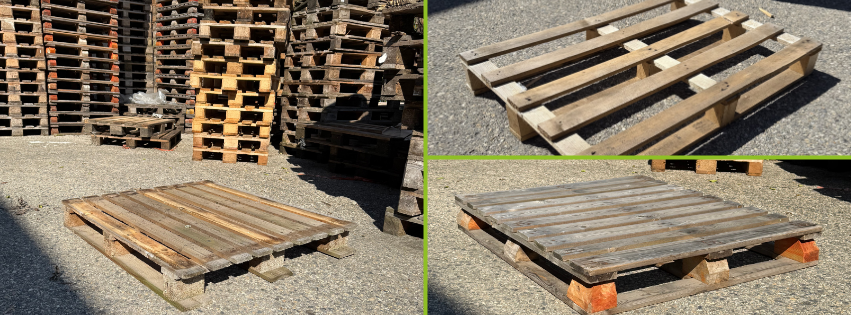In the world of transport and logistics, logistics pallets play an essential, if often underestimated, role. The backbone of the global supply chain, these simple structures – whether made of wood, plastic or metal – are used every day to handle, store and transport billions of tonnes of goods around the world. Behind their apparent simplicity lies a rich history, precise engineering and remarkable versatility. From their invention to the most creative uses outside the logistics sector, let’s find out why the logistics pallet has become an essential tool for transport, storage and distribution professionals.
The history of the palette: a simple invention that became universal
The origins of the palette
The history of the handling pallet dates back to the beginning of the XXᵉ century. Prior to its invention, goods were loaded manually, which was labour-intensive and time-consuming. It was in the 1920s that the first wooden pallets appeared in the United States, alongside the development of the forklift truck. Their purpose was to make it easier to transport several parcels at a time by grouping them together on a single, stable support.
Industrial pallet, light pallet,… standardisation with the euro pallet
In Europe, the EURO pallet (or EUR EPAL) was born in 1961 thanks to a collaboration between the European railways. Its 1200 x 800 mm format became the standard, guaranteeing total compatibility with rail, road and logistics transport systems.
Today, this standardisation – confirmed by ISO 6780 – means that all companies, from small SMEs to multinationals, can use a universal format for storage and handling.
Although the euro pallet is still the standard today, other types of pallet with different dimensions exist(non-returnable pallets, industrial pallets or CP pallets), making their uses ever more diverse.

Ease of handling and transport
Efficient grouping of goods
Logistics pallets have revolutionised handling by enabling several parcels to be grouped together in a single load unit. This means greater stability and considerable time savings during loading and unloading.
Thanks to specially adapted accessories such as SBB frames, collars and metal reinforcements, the pallet can be adapted to all types of goods, even bulky or fragile ones.
Increased operational efficiency
The introduction of pallet trucks, forklift trucks and automated conveyor systems has made pallets even more attractive. Handling operations are now faster, safer and more economical.
In a modern warehouse, the passage of a product from production to delivery is almost entirely automated thanks to the compatibility of pallets with machines.
Reducing costs and timescales
By simplifying the logistics process, pallets contribute directly to reducing transport costs. Less manpower, less time lost, less damage: all this translates into shorter delivery times and greater profitability for companies.
Optimising warehouse storage
Maximising space
One of the great advantages of pallets is their standardisation. Standardised formats (ISO, EPAL, etc.) make it possible to optimise space in logistics warehouses.
Racking systems are designed to accommodate pallets of precise dimensions, allowing maximum use to be made of storage height and volume.
Simplified, automated management
Uniform pallets also make stock management easier. In connected warehouses, each pallet can be fitted with an RFID chip or barcode, enabling real-time traceability.
Warehouse management software(WMS) uses this data to locate, count and move pallets automatically, improving overall productivity.
Improving logistics security
Product protection
When transporting goods, the pallet provides a stable and secure base. By adding stretch film, straps or protective corners, products are better held and protected against impact, dust or moisture. This considerably reduces the risk of breakage or loss.
Worker safety
The use of pallets also reduces the risk of accidents by limiting manual handling. With the right handling equipment, operators can move heavy loads without excessive effort.
The result: fewer injuries, less fatigue and better workstation ergonomics.
International standardisation
ISO standards and certifications such as EPAL guarantee the worldwide compatibility of pallets. Whether products are being transported from France to Germany or Asia, pallets can be used without constraint. This global uniformity enhances the safety and reliability of the entire international supply chain.
The unusual and environmentally-friendly uses of pallets
A second life for pallets
As well as their logistical function, pallets are also becoming very popular in the recycling and DIY sectors. Their solid, untreated wood is easy to work with, making them ideal for creative projects.
A sustainable approach
The logistics pallet is also an example of circular logistics. Wooden pallets can be repaired, reused and recycled, limiting the consumption of natural resources and reducing industrial waste. Some logistics companies even specialise in pallet hire and reconditioning, promoting a greener economy.
Surprising ideas for use
Here are some of the most popular uses:
- Floors and terraces: assembled together, pallets form a solid, economical base for stages, terraces or temporary floors.
- Designer furniture: many private individuals and craftsmen transform pallets into benches, coffee tables, beds, shelves or planters.
- Sustainable gardening: by combining them with SBB frames, they become flower boxes or raised vegetable gardens.
- Eco-responsible decoration: the recycled wood from the pallets fits in perfectly with an ecological, zero waste approach.
Conclusion: a simple but essential tool
Logistics pallets are much more than just a means of transport. They are an essential link in the supply chain, making it possible to combine efficiency, safety and sustainability.
Whether to reduce costs,optimise storage space, protect goods or encourage recycling, their role remains central in a globalised economy.
A symbol of ingenuity and efficiency, the logistics pallet continues to evolve: now connected, reusable and eco-designed, it is an essential ally in the logistics of the future.

